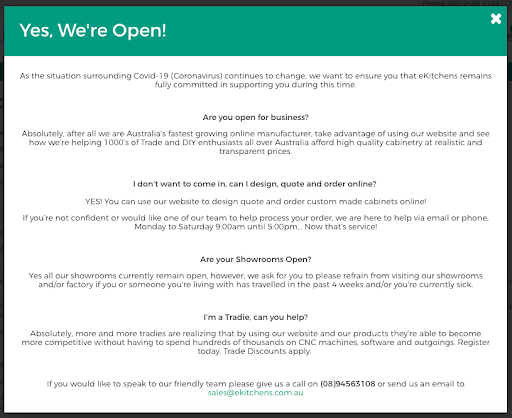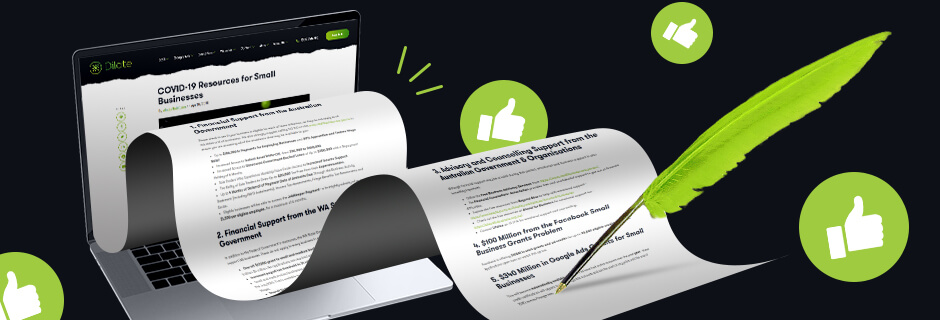

We’ve all felt the impact of COVID-19 on the way we live, work and socialise. A lot of us are now working from home, but even with these adaptations, unfortunately many individuals and businesses have suffered a financial hit.
With less disposable income to spend and more time being spent at home, it’s no wonder consumer behaviour has shifted. That’s not to mention stressors on supply chains, changes in the way media is consumed and increased anxiety about health. All of these are impacting the way people are spending their money.
Two of the major changes we’ve noticed are:
With these big shifts in consumer behaviour, it makes sense that our old SEO strategies might not cut it. So it begs the question: in this crazy, confusing climate, how do you shift your content and SEO strategy to remain relevant and stay afloat? Here are our tips on how to build an SEO strategy that helps you do just that...

Creating a page that is dedicated to COVID-19 (check out ours) can help capture relevant traffic and gives you an opportunity to build trust around your brand. Ideally, this page should focus on what your business is doing during this time.
For example, eKitchens created a COVID-19 info page and linked to it on every other page of their website. Here they answer FAQs that outline quickly and clearly how customers can still engage with their services. The copy is friendly and reassuring as it gives information about what eKitchens is doing to support their customers during COVID-19.

For your own website, consider what information you might want to communicate to your visitors: are you making donations or doing things to help the local community? Have you taken health and safety precautions such as empowering your employees to work from home? Have you made changes to the way you operate to make things more convenient for your customers?
Communicating these things to your website visitors can help create a sense of trust and personal connection. Trustworthiness is the T in EAT, making it one of the three key factors which affect your ranking on Google (the other two are expertise and authority). People are more likely to trust you if you’re sending a message of hope and empowerment at this time. Consider how you can present your products and services in a way that is sensitive and value-adding.

Simply put, the right content will attract more traffic. So if you want to capture traffic from the new search demand, you need to create content about the topics people are interested in. We get it... this is easier said than done. These days, the most searched for topics are rapidly shifting and so creating a solid SEO content strategy can be tough. You’ll need some good tools in your belt to do it successfully.
Here are two tools you can use when trying to create content that attracts traffic:
Google Trends is a great first port of call for understanding current search behaviours. Unlike some other keyword trend tools, Google Trends collects data in real time which will help you pick topics that are up-to-date.
Think of what keywords are relevant to your business and then add modifiers that are relevant to the current situation. For example, people are at home a lot of the time so modifiers such as “at home” “indoor” can help you gain more visibility. If inspiration is running dry, check out the Google Trends homepage (https://trends.google.com/trends/?geo=US ) to see what’s currently trending in different regions across the world.
Another nifty tool is Exploding Topics. Here you’ll find emerging topics, collected from the data from different search engines, conversations and mentions across the internet. You can find topics that are relevant to your business, and then use Google Search to see what other content already exists. From there, you’ll be able to determine what kind of content you will create and how you might structure it.
Be sure to create content that is relevant to your website and will add value to your potential customers. They’ll probably see through you if you’re just trying to ride a trend wave. Also, it’s a good idea to avoid any topics where you’ll be competing with really tough competition like big news outlets and government websites. Try and address more specific topics that speak to your industry and your customers' needs.

Assessing your website and making changes to improve your conversion rate is important at any time, but it can be especially beneficial right now. If business is slow for you at the moment, testing and making improvements to user experience and brand image are one of the best ways to spend your time. It might make all the difference during these coronavirus times, but it is certainly going to help you in the long run too. Improvements to increase conversions are never a waste of time.
Here are four areas you can tackle to help improve conversion rates on your website:
Use tools like Google Analytics and Google Search Console to identify which pages on your website have the largest declines, and which have the highest bounce rates. Thes pages probably need some pampering.
Ask yourself if the messaging on these pages is clear. Do the keywords and on-page content work together to create something relevant and valuable to the visitor? If not, make the necessary changes to align the search intent with your page’s content.
Friction points are those bits in your website which make it harder for visitors to convert. Think of them like hurdles visitors have to jump over: the more you have and the bigger they are, the less conversions you’ll get. Friction points can be anything from too many fields in a contact form to difficult-to-find information. Take a scout around your website and see if you can eliminate or minimise friction points.
You probably know why your products or services are valuable, but are you communicating that clearly to people who visit your website? What point of difference are you offering them over your competitors? Have a read up on your competitors’ sites and see how you could improve the value messaging on your own.
Think about the messages and emotions your website copy and imagery is sending in this coronavirus climate. Perhaps steer away from imagery of people holding hands, or hanging out in a crowd. Instead, use visual and written content which people can identify with better at this time. Set them up to feel connected - rather than disassociated - with your brand.

Some of the strategies we’ve mentioned in this article will not only be beneficial during this time of COVID-19... many of them are good practices that will help set you up for long term success. If anything, this is a reminder that SEO strategies are like living things that need to grow and adapt to the environment. A one-off quick-fix will never compare to a long term SEO strategy that can adapt for success in the long run.
If you would like to adapt your SEO strategy for COVID-19 but don’t know where to start, chat with us at Dilate Digital. We’re a digital marketing agency, specialising in SEO in Perth, and we’re passionate about helping businesses like yours thrive. If you want to check out what we’re doing during COVID-19, head here.
what our clients are saying
create business. better everyday.
Let's Talklearn from the best minds in the business
Bodie provides some insight into Dilate's internal operations. How we approach what we do, and how we strive to be Better Everyday.





